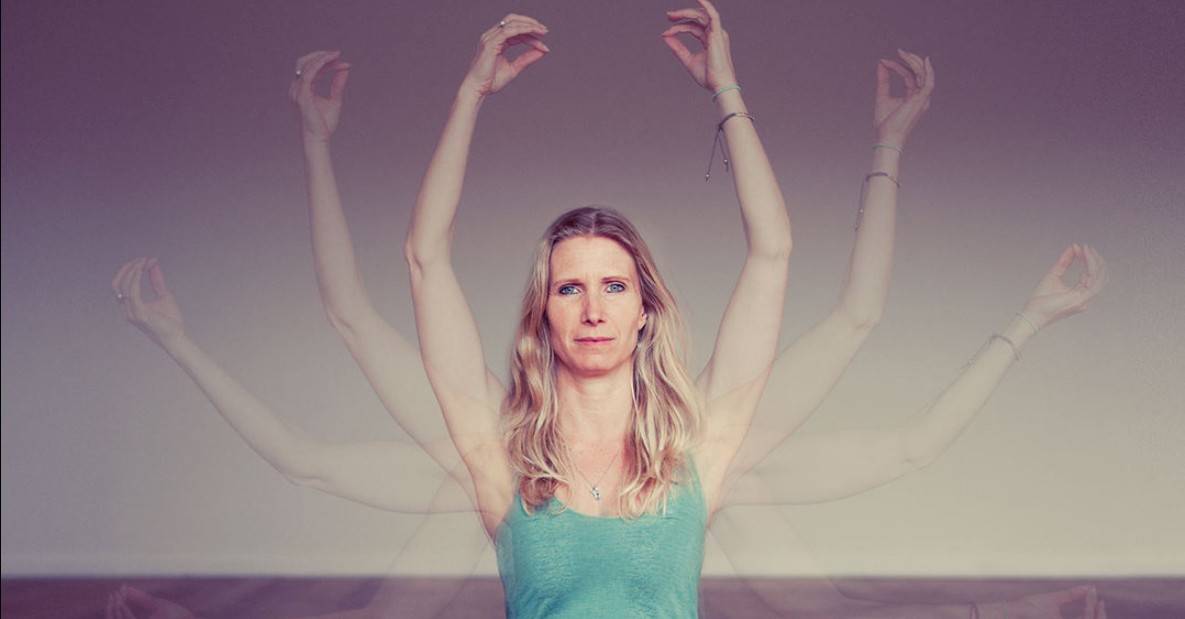The Niyamas lead us towards a more positive relationship with ourselves, which is important as we cannot form authentic and sustainable relationships with others until the connection with ourselves is strong. Santosha often translates as ‘contentment’, and as we all know – contentment isn’t the easiest thing to practise….
How often does the phrase ‘I’ll be happy when….’ Cross your mind?
Even if we’re dedicated practising yogis, doing everything ‘right’, there’s still probably that niggling thought of ‘I’d be happier if….’ in our minds. Whether its losing weight, getting a different job, meeting someone new, or being able to get ourselves into that yoga posture we’ve been working towards, there’s probably one or two things you feel could make you happier or more content. Now, having the urge to want to grow and expand our minds and push ourselves just a little towards a goal isn’t a bad thing at all – it just becomes bad when we base our entire sense of peace and happiness upon this.
Santosha or ‘contentment’ doesn’t mean idly sitting back and relinquishing the need to do anything. It simply means accepting and appreciating what we have and what we are already, and moving forwards from there.
Santosha or ‘contentment’ doesn’t mean idly sitting back and relinquishing the need to do anything. It simply means accepting and appreciating what we have and what we are already, and moving forwards from there.
OK, so this may not seem so simple at first – if it were then we’d all be a lot more content with ourselves instead of constantly looking for the next thing that promises to make us ‘better’. This is a difficult practice indeed; it is in our nature to want more, to not let ourselves rest until we’ve satisfied some temporary urge – and this is really what has helped us survive as the human race!
But we do have to consider what goals are really important to our life, our world and our wellbeing. Getting that promotion, losing weight, buying the car, the house or even meeting someone and falling in love are all things that we seek outside of ourselves in order to make us happy – and sooner or later those things (or at least the initial joy of those things) leaves. Once we’ve fixed something in our lives, another thing seems to break. It’s an endless spiral of juggling happiness, sadness, love and fear. So how do we escape this and move further towards that sense of Santosha?
The answer lies in non-attachment or ‘Vairagya’ and appreciation of our true selves.
The well known yogic text The Bhagavad Gita teaches us not to look outside of ourselves for happiness, but to realise that peace and happiness lies within. When we rely on things which are external to us to bring us freedom, we inevitably bind ourselves to discontentment even more. Our ego experiences joy, pain, loss, desire, greed and happiness, and we ultimately become attached to these experiences by either attempting to push them away, or by clinging to them – either way, it doesn’t tend to end well…
We are subject to change
You may be familiar with Patanjali’s philosophy which threads its way throughout the sutras, and puts forward the theory that our bodies and minds are part of creation, nature or prakrti, and who we truly are lies beneath. Realising this, we can come closer to accepting that as nature constantly changes around us – the weather, the seasons, temperatures and life cycles – our body and mind too are subject to change. What made ‘us’ (and by ‘us’ I mean our body, mind and ego) ecstatic one moment may cause grief the next, but who we truly are underneath is unchanging, pure and true, and more than good enough!
If you’re looking for happiness, look no further – it’s already inside you, and there are plenty of ways to uncover it on and off the yoga mat.
If you’re looking for happiness, look no further – it’s already inside you, and there are plenty of ways to uncover it on and off the yoga mat.
Santosha on the mat
Anyone who’s ever been to a yoga class knows the feeling; you’re working your way into a posture and you just can’t help but take a peek around the room to see whether you’re doing ‘better’ than someone else. Admit it – we’ve all been there at least once!
The truth is, whether we can walk on our hands or whether we find staying in downward facing dog for more than ten breaths a challenge – there will always be further to go and more to explore in our practice. The good news is, we have a lifetime to practise in! There is no deadline for being able to reach a certain ‘level’ of physical practice.
Indeed, it may be difficult to accept ourselves as we are if that means we can’t do what we want to be able to do yet, but being just where we are now and moving forward from there is the key to a sustainable and transformative practice. When we push ourselves physically into an asana we’re just not ready for yet, our body responds by contracting, becoming rigid and almost defending itself against our incessant forcing. The more we work from a place of fear, attachment and pushing, the further away we push ourselves from where we’re trying to go.
In your next yoga class or home practice – make the intention to appreciate yourself for what you are, how far you’ve come and all that you have to look forward to. Your body will thank you, and when we let go of the ‘need’ to be more flexible, stronger, balanced or powerful, that power comes to find us in no time.
- EkhartYoga members: In the class Gratitude, Sandra encourages you to cultivate a sense of gratitude to foster contentment on the mat.
Santosha off the mat
Constantly chasing after a feeling, a physical possession, or a person can become exhausting after a while. Yes, of course we’ll experience temporary joy or happiness once we’ve conquered what we wanted, but how long does it really last? Once we’ve reached that place of temporary peace, we ultimately become very attached to this feeling, and fight to keep hold of it, eventually leading to sadness again until we find that next goal to make us ‘happy’.
Just as in nature, our minds are constantly changing; emotions and states of being are totally impermanent, yet at times we find ourselves caught up in a whirlwind of worries with seemingly no escape. The promises we make to ourselves, like ‘I’ll be a better person once I’ve done this’, I’ll just lose ten pounds and then I’ll be ok’, ‘I’ll be happy when I get that job/relationship/car/money….’ all cause us to completely disregard the present moment for the beautiful and perfect moment it is right now.
Searching outside ourselves for happiness in any form, whether it be substances, people or possessions, just leads to yet more searching.
Searching outside ourselves for happiness in any form, whether it be substances, people or possessions, just leads to yet more searching.
The things around us, our experiences and our emotions are constantly changing as they are part of prakrti or nature, but our true Self is completely unchanging. Who we really are and always will be is completely good enough already.
We have a habit of waiting to ‘be ourselves’ until we’ve accomplished this never-ending to-do list of things that will make us ‘better’. Well, the truth is – you will always be you, and you can either continue to disregard your awesomeness in favour of reaching towards something you think you’re supposed to be, or appreciate it, love it, and be the best you you can be right now. Truly, authentically, unapologetically you. Content with all you are and all you have, because there is no one else who can offer the world what you have to offer.
In order to come closer to finding peace, Santosha is undeniably one of the most important practices to come back to consistently – we cannot love, trust, give or live fully until we have enough of that love inside ourselves.
The most important message to take away from this? Do not wait for happiness. You have everything you need right within you, so get out there and do whatever it is you’ve been waiting to do until you’re ‘good enough’, because you already are.
Emma
EkhartYoga members:
Explore Patanjali’s 8 limbs of yoga in our 8 week program
If you’d like to explore the Niyamas in practice, follow our program ‘The Eight Limbs of Yoga‘. In this 8 week program our aim is to help you achieve a good grasp of each limb through informative talks, yoga, Pranayama and meditation. Go deeper and truly enrich your yoga practice and hopefully, your life.
Further reading
The other Niyamas:
- Saucha (cleanliness)
- Tapas (Discipline, austerity or ‘burning enthusiasm)
- Svadhyaya (Study of the self and of the texts)
- Isvara Pranidhana (Surrender to a higher being, or contemplation of a higher power)


